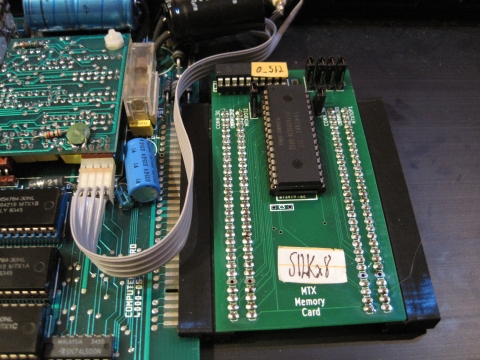|
 |
The Memotech MTX Series |
 |
Memotech MTX RAM Fault Diagnosis / Repair
Courtesy of Mark Kinsey

System Description : MTX 512 Serial No.18109, 4000-05
computer board with 64k DRAM chips.
Problem Description : A blank picture and a continuous
tone on sound when powered
[These symptoms were the same as when Andy and
Dave
tried to upgrade their MTX500s to 512s and introduced a RAM
fault, so they had a good idea where the problem lay. Mark
diagnosed a RAM fault from scratch by following the steps below.
It may be that a RAM fault can always to be taken as the likely
cause for the symptoms described above.]
Background
This MTX512 was bought from eBay as "not working". Last year I
checked the power supply section. All three regulated supplies
were in spec (+5V, -5V and +12V). I also tested the Z80 address
and data buses plus the Z80 control lines. This showed that the
Z80 was doing something.
Fault Finding
If you look into eight bit micro computer failures, rather a
lot of faults are due to DRAM chip failure. So I suspected that
one (or more) failed DRAM chips was causing the fault.
One symptom of a failed integrated circuit (IC or chip) is
excessive heat dissipation. So using the simple touch with
finger test, I checked each DRAM chip in turn. The OKI
M3764-20RS chips making up the main memory were not hot, but
some of the ITT 4116 3N chips making up the video memory did run
hot. Now if it was just the video DRAM that was faulty, I would
have expected video problems, but no problem with the sound.
This machine just produced a blank picture and a continuous tone
on sound when powered. So was the main memory faulty or was
there a problem elsewhere?
A known working Z80 CPU made no difference to the symptoms
(not that I expected it to...).
My next step was to develop a test ROM (as with the right
program, a Z80 is happy to run a program from ROM and does not
need any RAM). However, real life delayed this.
In the MTX community, there is a very helpful person who goes by the name
Andy Key. Since I started searching for MTX information on the web in 2011, a
number of new web sites have appeared, and continue to grow with lots of
interesting information. Andy's site (http://www.nyangau.org/memotech/memotech.htm)
gives details of a number of new products, one of which is a new design of
memory card (MTX Memory
Card) that uses one large SRAM (static RAM) chip and a GAL chip (for the
decoding). So I emailed Andy and ordered one. A short time later, it arrived.
Yesterday after doing some additional checks, I worked out how to disable the on
board main DRAM (memory).
Memory Operation
All DRAM chips use a multiplexed address bus. That is, you
will find only half of the address pins are present compared to
the number you expect. So for a 64 kbit DRAM chip, there is only
8 address pins (you need 16 address lines/bits to address the
range zero to 64k).
Extra circuitry multiplexes the address lines from the Z80
CPU to the DRAM chips, so that the address is supplied in two
lots. First the row address and then after a short pause, the
column address.
On each DRAM chip there are control pins that tell the DRAM
chip which address information is being supplied, these are
called /RAS+ and /CAS+.

As the /CAS signal is delayed, and the typical way to do this
is with a resistor-capacitor-logic chip delay circuit, all that
is required is to work out the logic, and force the input of the
logic gate after the resistor to the correct logic level. Then
the /CAS signal will never go to the active state, hence the
on-board DRAM will never be selected. This then allows the Z80
CPU free access to the SRAM chip on the MTX Memory Card.
So having studied the circuit schematic, the simplest way of
disabling the /CAS signal is to short out capacitor C6 (at board
location B4) with a wire. I used a test lead that I have that
has small clip on probes – see pictures.
So I attached my “shorting strap”, connected the MTX to a
display and powered up – with the on board DRAM disabled I had
exactly the same symptoms as before (as expected).
I powered down. Plugged the correct GAL (for zero on-board
main RAM) in to the MTX Memory Card, then connected it to the
MTX.
Turned the power on and it worked. It displayed "READY" on the
normal BASIC screen.
Okay, time to connect the keyboard. A bit of typing and I had
entered a simple BASIC test program. This ran okay and proved
that the machine was working normally.
Here is a picture of the MTX Memory Card fitted:-

I hope you enjoyed this and I hope it is helpful.
+Note: /CAS & /RAS signify that the signal is
active low
|